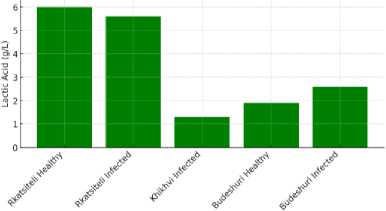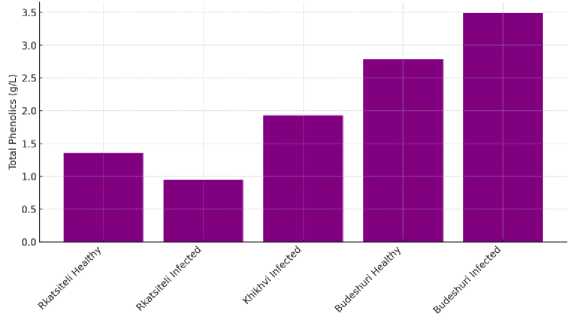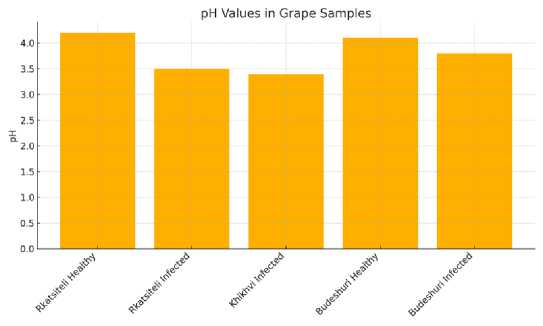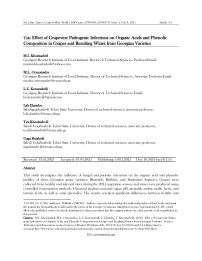Effect of Grapevine Patho-genic Infections on Organic Acids and Phenolic Composition in Grapes and Resulting Wines from Georgian Varieties
Автор: M.I. Khositashvil, M.L. Ormotsadze, L.Z. Kotorashvili, L. Elanidze, T. Khositashvili
Журнал: Science, Education and Innovations in the Context of Modern Problems @imcra
Статья в выпуске: 4 vol.8, 2025 года.
Бесплатный доступ
This study investigates the influence of fungal and parasitic infections on the organic acid and phenolic profiles of three Georgian grape varieties: Rkatsiteli, Khikhvi, and Budeshuri Saperavi. Grapes were collected from healthy and infected vines during the 2024 vegetation season, and wines were produced using controlled fermentation methods. Chemical analyses assessed sugar, pH, titratable acidity, malic, lactic, and tartaric acids, as well as total phenolics. The results revealed significant differences between healthy and infected samples, including reduced malic acid and elevated lactic acid in diseased grapes, and increased phenolic content in infected Budeshuri Saperavi. These findings offer critical insight into the metabolic responses of traditional grape varieties and serve as a foundation for climate-resilient viticultural and enological practices.
Organic acids, Grape diseases, Malic acid, Wine quality, Botrytis cinerea, Viticulture, Fermentation, Phenolic compounds
Короткий адрес: https://sciup.org/16010574
IDR: 16010574 | DOI: 10.56334/sei/8.4.14
Текст научной статьи Effect of Grapevine Patho-genic Infections on Organic Acids and Phenolic Composition in Grapes and Resulting Wines from Georgian Varieties
Organic acids are fundamental to the chemical and sensory profile of both grapes and wine. They not only determine the perceived freshness and taste balance but also play a central role in ensuring microbiological stability during fermentation and storage. Among these, malic, tartaric, and lactic acids are the most significant. Malic and tartaric acids are naturally occurring in grapes, with malic acid levels typically decreasing during ripening due to respiration, while tartaric acid remains more stable. Lactic acid, on the other hand, is primarily a product of microbial activity, especially during malolactic fermentation.
Scientific literature highlights that the decrease in acidity accompanied by an increase in sugar content during grape ripening is a natural physiological process that shapes the final organoleptic properties of the wine (Dittrich & Grossmann, 2011). However, this balance can be severely disrupted by biotic stress factors, particularly fungal infections such as Botrytis cinerea and Plasmopara viticola. These pathogens alter the grape's metabolic pathways, resulting in significant modifications of the organic acid profile. Specifically, infected grapes often exhibit a decrease in malic acid due to enhanced microbial metabolism, as well as an increase in lactic acid, which is associated with secondary fermentation. These infections can also distort the phenolic composition, leading to changes in wine color, astringency, and antioxidant capacity (Teissedre & Donèche, 2013;
The effect of such diseases extends beyond the sensory characteristics of the wine. The structural integrity and biochemical composition of the berries are compromised, which can diminish the wine's stability, storage potential, and consumer acceptance. Moreover, the increase in vineyard disease incidence in recent years, driven in part by climate change, has intensified concerns in the viticulture sector. Climate-induced shifts in temperature, humidity, and rainfall patterns are creating favorable conditions for pathogen proliferation, making disease management more complex and unpredictable.
These developments highlight the urgent need to evaluate how grapevine diseases affect key quality parameters, particularly organic acids and phenolic compounds. In this context, traditional grape varieties — which often exhibit unique acid and phenolic balances — face increased vulnerability. Protecting these genetic resources and understanding how they respond to biotic stress is essential for maintaining the distinctiveness of regional wines and for sustaining viticulture in challenging agroecological conditions.
Therefore, the assessment of organic acid dynamics in both healthy and infected grape samples serves not only as a diagnostic tool for vineyard health but also as a strategic component of adaptive viticulture. It provides valuable insights for growers and winemakers seeking to preserve quality and optimize fermentation outcomes under the evolving challenges of climate change.
Materials and Methods
This research was conducted during the 2024 growing season in two prominent viticultural zones of Georgia: Shida Kartli (Saguramo subregion) and Kakheti. These regions were selected due to their diverse climatic conditions and disease prevalence, allowing for comparative analysis of healthy and infected grape samples under realistic vineyard scenarios.
Three traditional Georgian grape varieties were selected for the study:
Rkatsiteli (Vitis vinifera L.) – A widely cultivated white grape variety in Georgia, characterized by high sugar accumulation and low acidity at full ripeness. It is known for producing dry white wines with moderate aromatic intensity and relatively high alcohol levels.
Khikhvi (Vitis vinifera L.) – A rare indigenous variety primarily grown in Kakheti, valued for its naturally high acidity and well-developed phenolic profile. Khikhvi is often used in the production of both classic and amber (skin-contact) wines.
Budeshuri Saperavi (Vitis vinifera L.) – A colorintensive red grape variety, genetically close to Saperavi, known for its thick skin, deep pigmentation, elevated phenolic content, and robust tannic structure, making it suitable for wines with aging potential.
The experimental design included both healthy grape samples and samples affected by a range of pathogenic factors, including fungal and parasitic infections. Pathogens observed in diseased grapes included:
-
-Downy mildew (Plasmopara viticola);
-
-Powdery mildew (Uncinula necator);
-
-Gray mold (Botrytis cinerea);
-Mites (various species damaging leaves and clusters).
All harvested grapes were manually sorted and transported in ventilated boxes to avoid premature fermentation or spoilage.
Processing and Fermentation Techniques
The grape samples were processed at the experimental pilot facility of the Georgian Research Institute of Food Industry. Upon arrival, berries were manually destemmed and divided into three experimental groups to simulate traditional and modern vinification approaches:
-Crushed without stems – simulating classic white wine technology.
-Crushed with stems – used in traditional Kakhetian or “amber” wine methods.
-Juice fermentation only – representing sterile juice fermentation for analytical control.
Each sample underwent alcoholic fermentation with commercial active dry yeasts of Saccharomyces cerevisiae. The selected yeast strains were characterized by:High ethanol tolerance (14–15% v/v). Ability to maintain varietal aromatic characteristics. Rapid fermentation kinetics under moderate to cool temperatures.Fermentation conditions were as follows:White varieties (Rkatsiteli, Khikhvi): 14–16°C .Red variety (Budeshuri Saperavi): 24–28°C. Fermentation duration: 7–14 days, monitored daily
Fermentation progress was tracked through: Daily Brix measurements using a refractometer , CO 2 release monitoring by weight loss method . Upon completion of fermentation, samples were processed further:White wine samples were racked off the lees . Red wine samples were pressed and separated from the pomace
Chemical and Phenolic Analysis
All finished wine samples were subjected to comprehensive physicochemical analysis, using standardized methods: Sugar content (°Brix) – measured using a refractometer. Total titratable acidity – determined by titration with 0.1 N NaOH. pH – measured with a calibrated digital pH meter. Organic acids (malic, lactic, tartaric) – analyzed via a combination of enzymatic kits and classical titrimetric methods. Total phenolic content – measured spectrophotometrically at 520 nm, with results expressed as gallic acid equivalents (GAE)
Statistical Analysis
All data were processed using Microsoft Excel and OriginPro 2023. Statistical comparisons between healthy and infected samples were conducted using one-way analysis of variance (ANOVA). Statistical significance was determined at a confidence level of p < 0.05. All experiments were performed in triplicate, and results are presented as mean ± standard deviation.
Results

Lactic Acid Concentration in Grape Samples

Samples
The findings of this study provide compelling evidence that grapevine diseases have a significant impact on the organic acid composition of grapes, leading to measurable deviations in key chemical parameters when compared to healthy samples. The alterations in acid balance observed across the tested Georgian varieties—Rkatsiteli, Khikhvi, and Budeshuri Saperavi—demonstrate that disease pressure does not manifest uniformly, but rather exhibits variety-specific biochemical responses.In the case of Rkatsiteli, diseased grape samples showed a marked decrease in malic acid concentration (0.44 g/L) along with a noticeable increase in total titratable acidity. This suggests an accelerated degradation of malic acid—likely due to microbial activity such as lactic acid bacterial metabolism—coupled with the accumulation of other acidic components, potentially including lactic and acetic acids. These changes are indicative of stress-induced shifts in grape metabolism and confirm the susceptibility of Rkatsiteli to acid-related transformations under biotic stress. Conversely, Khikhvi—a variety known for its naturally high acidity—retained a comparatively elevated level of malic acid even in the presence of disease (0.97 g/L). This result implies a different interaction between the variety's metabolic pathways and the invading pathogens. The relatively stable malic acid concentration in diseased Khikhvi grapes may be attributed to either delayed degradation or greater resistance to microbial breakdown, highlighting Khikhvi’s potential resilience and unique physiological response to infection.
These differences underscore the importance of varietal identity in determining disease impact, suggesting that certain grape varieties may inherently possess greater metabolic buffering capacity under pathogenic stress. From a practical perspective, these results emphasize that disease management strategies should be tailored not only to the pathogen profile but also to the specific variety's biochemical characteristics. Furthermore, the observed increase in titratable acidity, despite the decrease in malic acid, reflects the complexity of acid transformation dynamics during disease progression and fermentation. Such shifts can significantly affect the sensory attributes and stability of the final wine, necessitating additional corrective measures during vinification (e.g., acid adjustments or tailored fermentation protocols).In summary, the study highlights that:The composition of organic acids is highly sensitive to pathogen-induced stress.The degree of change varies across grape varieties, revealing differences in metabolic responses.Malic acid degradation is a useful marker of microbial activity in diseased fruit.Understanding these varietal patterns is critical for preserving wine quality and guiding adaptive oenological practices.
Total Phenolic Compounds Concentration

Figure 4. Total Phenolic Compounds Concentration
The analysis of total phenolic compound concentrations across healthy and diseased grape samples reveals significant differences, with variety-specific trends emerging: Budeshuri Saperavi exhibited the highest phenolic content among all samples, with a notable increase in the infected grapes (from 2.8 g/L to 3.5 g/L). This elevation is likely the result of pathogen-induced cell wall degradation, which enhances the extraction of phenolic compounds such as anthocyanins and tannins from grape skins and seeds. The intensified extraction is consistent with the known effects of Botrytis cinerea and similar pathogens, which secrete enzymes that break down plant tissue structures.Khikhvi, although a white grape variety, demonstrated a higher phenolic concentration in diseased samples (1.95 g/L) compared to both its healthy counterparts and Rkatsiteli. This suggests that Khikhvi may possess a more complex phenolic profile and a higher susceptibility to oxidative enzymatic activity under disease stress.Rkatsiteli showed a decrease in total phenolics under infection, dropping from 1.36 g/L in healthy grapes to 0.95 g/L in diseased ones. This decline may indicate phenolic degradation, polymerization, or oxidation during fungal invasion, which can reduce extractable phenolics and impact color, antioxidant capacity, and mouthfeel of the resulting wine. Decreased or oxidized phenolics, especially in white grapes, may compromise sensory balance and stability, requiring careful intervention during vinification (e.g., antioxidant additions or clarification strategies).
These findings point to the dual role of vine diseases in phenolic development: while some infections may enhance phenolic extraction, particularly in red grape varieties like Budeshuri Saperavi, others may degrade or destabilize phenolic compounds, especially in more delicate white varieties.

Figure 5. Total phenolic compounds in different grape samples.
pH is a critical indicator of wine’s chemical stability, microbial resistance, and sensory attributes. In the present study, pH levels were evaluated in both healthy and diseased grape samples to assess the impact of grapevine infections on acid balance during grape ripening and fermentation.Healthy grape samples demonstrated relatively lower pH values, indicative of a stable acid profile and enhanced preservation potential for the resulting wines.Diseased samples showed elevated pH levels, correlating with observed changes in organic acid content—specifically, a decrease in malic acid and an increase in lactic acid concentrations.The rise in pH is likely associated with enzymatic degradation and increased microbial activity, particularly lactic acid bacteria proliferation, which may be facilitated by Botrytis cinerea infection.
Conclusion
-
1. Pathogenic infections in vineyards, particularly downy mildew (Plasmopara viticola), gray mold (Botrytis cinerea), and mite infestation, exert a significant influence on the biochemical composition of grapes, especially on their organic acid profile. These alterations are of critical importance, as they directly affect the quality, stability, and aging potential of the resulting wines.
-
2. The analysis of infected grape samples revealed a marked decrease in malic acid concentrations, coupled with an increase in lactic acid levels. This shift indicates the intensification of microbiological activity during fermentation, particularly the proliferation of lactic acid bacteria, which are known to thrive in damaged grape tissue. Such metabolic changes can compromise the freshness and structural balance of wines if not properly managed during the winemaking process.
-
3. Maintaining a balanced organic acid profile is essential for ensuring wine stability, microbial safety, and sensory harmony. The findings underscore the critical need for integrated disease management practices in vineyards, not only to preserve crop yield but also to safeguard the chemical integrity of grapes. Timely phytosanitary interventions can help reduce the risk of acid imbalance and undesirable fermentation by-products in wine.
-
4. This research provides a valuable scientific foundation for the advancement of viticulture and enology in Georgia and beyond. The results support the need for developing adaptive vineyard management strategies that take into account both biotic stress factors and climate-induced challenges.
The study confirms that grapevine health plays a central role in shaping key enological parameters.
By closely monitoring organic acid dynamics and pathogen impact, winegrowers and producers can implement informed decisions that ensure quality preservation, varietal expression, and long-term sustainability of wine production in a changing environment.


